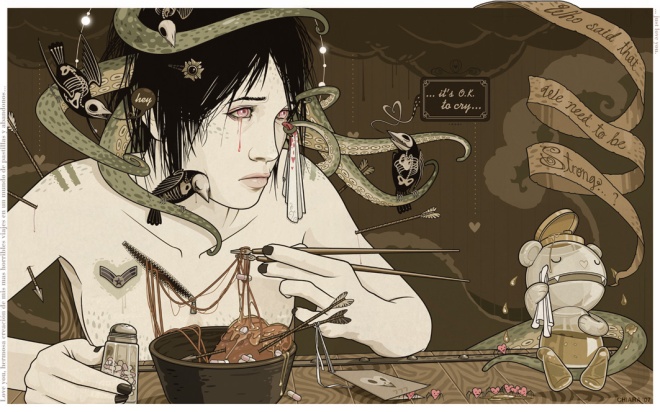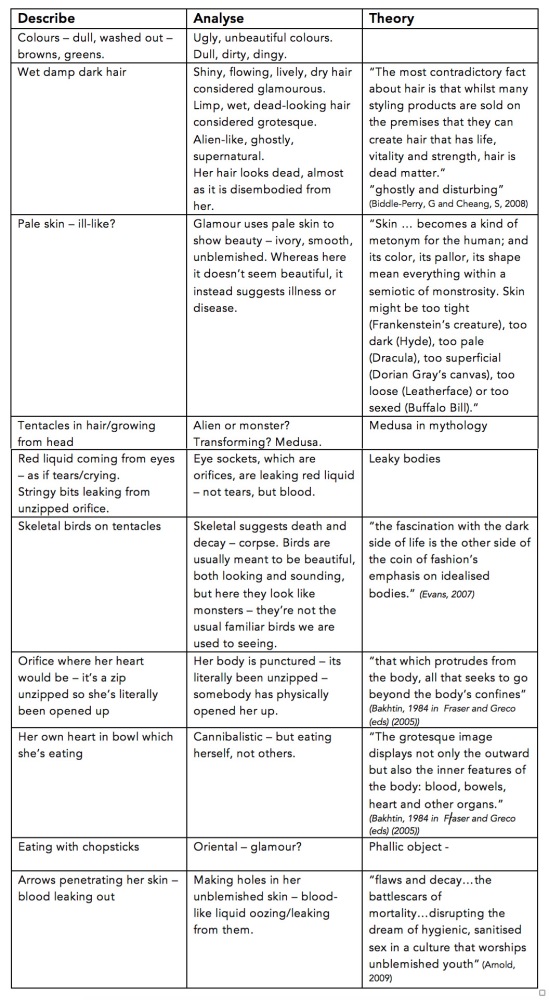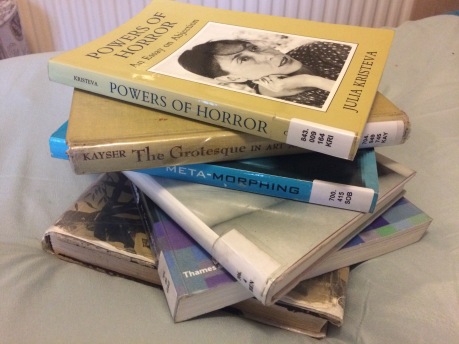Constellation Study Group Reflections
The process of completing my columns analysis for my formative assessment:
The columns analysis is made up of three columns: describe, analyse and theory. The method is used to analyse all sorts; from photos, to case studies, to working methods… practically anything and everything. For example, for my formative essay, I was looking at a piece of digital art by Chiara Bautista (AKA Milk), so I used the columns analysis method to analyse it. From the image, I analysed a range of parts to put in my essay, including: the orifice in the figure’s chest, her skin, the red liquid dripping from her eyes, the tentacles in her hair, the chopsticks, the arrows in her skin, etc.


Difficulties I encountered when filling in the second and third columns:
The third column, which is the ‘theory’ column, is the most difficult column to fill out. I was finding it difficult to find suitable quotes and information in some cases for the highlights that I had picked out from Milk’s piece. I felt that the main reason for these difficulties was that not all of the readings that we had looked at were relevant to what I wanted and needed to write about in my essay.
How I overcame some of these difficulties:
I borrowed loads of books from the library that related to my first and second columns. Rather than look for books specifically relating to each individual point that I was wanting to theorise from Milk’s image, I decided on a more abstract approach and searched for books which had the subject of the ‘grotesque’ – this seemed to work well for me and I was able to include a lot of my readings in my bibliography at the bottom of my essay. When I began to look at the grotesque more widely, the subject became so much more interesting and I suddenly felt that I was finding much more information that I could use.

Significant concepts/theories that have emerged in my columns analysis and why these have interested me:
During my columns analysis of Milk’s digital illustration, I realised that the ‘grotesque’ in general, rather than ‘glamour’ was something that I found really interesting. In particular, I was intrigued by the idea of skin, and the penetration or destroying of it – the theory that skin is the barrier between the insides and outsides of our body completely captivated me. I focused a large part of my essay on this, as well as the idea of ‘meta-morphing‘ which was a completely new concept to me on finding it in my own research. It is similar to the idea of transformation, which we learnt about with Cath Davies in our study group, from human being to monster. I was surprised at how much the unusual and ugly side of art interests me, because through all its gore and carnage, there is a hidden beauty that really compels me.
How approaches in this study group can help me with the development of my ideas and ways to progress next term, e.g. for dissertation preparation and for my other modules:
I feel that the columns analysis technique that we have been using in our study group will come in handy, not just in constellation, but in my subject and field too, as well as my dissertation planning and writing. I can use the analysis method to analyse my own work in order to help me to understand how the viewer would perceive it when looking at it – it will allow me to take a step back and look at it from the viewer’s perspective, rather than the designer’s.
Learning Process Reflections
How could the concepts and theories from my study group help with developing ideas in my studio practice?
There is certain aspects from this constellation study group that I feel I will not be able to stop noticing in the real world, for example, phallic objects – suddenly they are everywhere. I’d like to hope that perhaps I can even link in the grotesque to my work somehow, just because of the bizarre beauty it has.
What has been useful in the analysis and writing about others’ work in Constellation sessions?
In the same way that I will not be able to stop noticing phallic objects everywhere in the real world. This will most likely be similar for the that I look at my own work within both my subject and field work, not specifically in terms of phallic objects, but in the way that I will be able to assess and analyse my own work in the same way that we analysed other artist’s work and case studies in constellation.